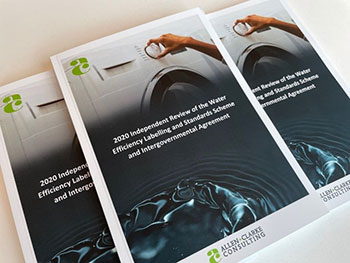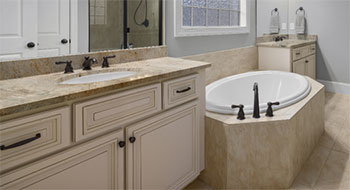InkWELS newsletter
Water Efficiency Labelling and Standards (WELS) scheme
Issue 2, 2022
Our newsletter is published to keep you updated on the latest developments. If you have any topics you would like to see covered, please email us at wels@dcceew.gov.au
WELS scheme receives top marks for a third time in a row
The third independent review of the Water Efficiency Labelling and Standards (WELS) scheme and Intergovernmental Agreement was released on 28 September 2022.
The review is conducted every 5 years and found that the scheme is still highly effective in reducing demand for water across Australia. It also made several recommendations to strengthen and broaden the impact of the WELS scheme.
This year alone, the scheme is expected to save Australian households and businesses nearly $1.5 billion through lower utility bills and water savings of 158 gigalitres.
Have your say on the WELS Cost Recovery Implementation Statement
You can now provide your feedback on the draft 2022-23 WELS scheme Cost Recovery Implementation Statement (CRIS) on our Have Your Say platform. The survey will close 4pm (AEDT) 28 October 2022.
This is an administrative update to the 2014 CRIS and has no changes to the current charging arrangements.
We intend to commence a full review of the cost recovery arrangement supporting the WELS scheme in 2023.
During the current review, we will consult on the cost of administering the scheme and options for a future cost recovery model.
Online marketplaces support WELS Australian standard
Online compliance is one of our key focus areas. We have been working with AliExpress, Amazon, eBay, and Wish to ensure that their sellers only offer WELS compliant products.
Recently AliExpress went a step further in September by imposing a platform-wide ban which removed hundreds of thousands of non-compliant products. AliExpress have made it a mandatory part of its sellers onboarding process to ensure that Australian consumers will only be able to shop for taps and showerheads that meet the WELS Standard (AS/NZS 6400:2016A).
"We are pleased to collaborate with the Australian Government to ensure that our Australian customers can only purchase WELS rated products," Pier Smulders, General Manager (Aus & NZ) of Alibaba said.
Lessons from WELS water savings program presented to the world
Kirsty Bunfield, senior executive for the WELS scheme, was recently invited to share learnings on managing the WELS scheme with 250 international participants on a webinar organised by the European Energy Network.
This was a great opportunity for us to share our leadership and expertise with our European counterparts who are considering different labelling scheme options to improve consumer label understanding and help them save water and energy.
You can watch the video recording that charts our story from its inception in 2005, at the height of the Millennium Drought. Our scheme is recognised as a valuable model for other countries who are embarking on a similar scheme.
Slide 2
Thank you for inviting me to share our insights on Australia’s experience on implementing a water efficiency labelling program.
The Water Efficiency Labelling and Standards scheme or WELS for short was established in 2005 as a national instrument to encourage more efficient domestic water use and reduce demand for potable water by informing consumers about water efficiency at the point of sale.
I hold the role of the WELS Regulator in the Australian Government’s Department of Climate Change, Energy, the Environment and Water. Today I will give you an overview of our experience and learning in implementing this scheme.
Slide 3
The scheme started off as a small voluntary scheme in 1988 in one of our eight states and territories, led by a local water utility company. It used A ratings as seen in the left hand side image.
The scheme grew slowly with new products being added every few years.
During this time the responsibility for running the scheme moved between government committees, standards setting bodies and water utilities.
Unfortunately there was not enough voluntary uptake of the scheme by industry. Companies were not registering their products, and consumer awareness and demand for information about water efficiency of products was not yet cultivated.
The tipping point came a few years into a long and severe drought in Australia. The drought started in 2001 and lasted until 2009. It devastated many communities, industries and our environment across large areas of Australia.
Water management became a matter of national significance. It led to a reform of water management in Australia with the Australian Government taking the lead on better management of water.
Mandating and legislating the WELS scheme in 2005 formed part of that response.
Slide 4
From 2005 WELS became a mandatory national scheme under the WELS Act.
The objectives of the Act are to: conserve water supplies - inform consumers about water efficiency at the point of sale - and promote innovation and adoption of efficient and effective water saving technologies
The WELS Act is supported by complementary legislation in each Australian state and territory.
This ensures a nationally consistent legal framework across Australia, setting the goals and regulatory functions of the scheme, including powers to monitor and enforce the scheme requirements.
This covers - the performance requirements for the water consumption of each type of product - how to apply a water efficiency rating - and the water efficiency information that must be shown when the products are offered for sale.
It does not include the energy saving for the product as part of the water efficiency.
Slide 5
Under the Australian scheme, we regulate taps, showers, toilets, urinals, flow controllers, dishwashers and washing machines.
These are mainly household products. In Australia that covers around 9.8 million households.
While we haven’t regulated commercial products - standard taps, toilets and urinals are used in many public and commercial settings like hotels, shopping centres and offices.
Currently we have over 22,000 products registered for the Australian market.
If they are not registered and labelled properly, and in accordance with the standard, they cannot be offered for sale in Australia.
The information about the product’s efficiency must also be easily visible to customers. This includes products available in a physical store as well as those sold online.
Slide 6
My team manages the administration, compliance and enforcement of the scheme and engaging with our many stakeholders including industry and other governments.
There is a growing movement about sustainable living and on the back of many public awareness campaigns about saving water in the home, the Australian public - as consumers - are recognising and using the WELS scheme to choose efficient products and to save water.
A survey last year showed that 69% of respondents recognised the label. The public are demanding more efficient products through purchasing power.
The mandatory standards have also driven the innovation in manufacturing over time, and the plumbing and appliances industries acknowledge and support the changes that the scheme is making in saving water.
As the scheme has matured and grown in acceptance, it is now relied on by many other programs and has for example been integrated into the calculators for sustainable housing and building schemes in Australia.
The scheme is also supported and enabled by national building codes – legislation that requires that all showers, toilets, urinals and taps over a basin must have a minimum water efficiency – for example - 9 litres a minute for showers.
And the last point on this slide is that through the WELS Australian Standard, we have set the minimum water efficiency for all the products that can be registered for the Australian market.
Slide 7
Most importantly, the scheme is working.
Reducing the water used means reduced water and water heating bills for the life of the product in homes and in businesses.
Based on modelling, the water savings are expected to be 158 gigalitres of water nationally this year and this is set to increase to 230 gigalitres by 2036.
That’s worth AUD $1.47 billion this year alone to the Australian economy and to the hip pocket of Australians - and a reduction of 2.3 megatonnes of carbon dioxide equivalents.
The modelling report is available on our website.
The modelling is for people connected to utilities but the savings go further than this. It helps Australians in remote communities who are off the grid and are relying on rain water, tanks or dams for their water supply to make their water last longer.
The image at the top is a tweet from our Minister for the Environment and Water - promoting the scheme.
Slide 8
You may be interested to know that Australia also has a energy efficiency labelling scheme called the Equipment Energy Efficiency Program.
It has a similar regulatory framework, national legislation and product standards about performance and labelling requirements.
It currently regulates 22 products and overlaps with WELS labelling for both washing machines and dish washers. As such these two products have to have both labels displayed on them like the dishwasher you see in this picture.
You can find out more about this scheme on their energy rating website.
Slide 9
I would also like to let you know about the new ISO standard for Water efficiency labelling programmes – the ISO standard 31600:2022
Given that we in Australia recognised that managing the demand for precious water was important globally, we proposed and led the development of this international standard for water efficiency labelling programs.
You can find it on the ISO website shown here.
We started developing the standard in 2018 and worked with 37 member nations to draft and publish the standard, which was finally published in June this year.
The standard is based on schemes that are operating successfully, including our WELS Scheme.
This standard sets out four key requirements to establish a effective water efficiency labelling scheme, including testing and labelling guidance. It also provides a benchmark for countries with existing water efficiency labelling schemes to assess themselves.
But more importantly, the ISO standard provides countries without a scheme with a pathway to establish a water efficiency labelling program that will save them water, energy and reduce carbon emissions.
Slide 10
Thank you for your attention.
For more information about the scheme please visit our website at waterrating.gov.au
You are also welcome to email us or subscribe to our newsletter.
The WELS scheme will feature at the Australian stand in the Water Pavilion of the United Nations Climate Change Conference UNCOP27, to be held in Sharm El-Sheik, Egypt in November 2022. By reducing demand for water that is treated and heated, the WELS scheme is reducing carbon emissions in Australia and helping us to lessen the impact climate change.
Progress on consultation for new product registration system
The first steps to developing our new product registration system is progressing well. We have finished gathering valuable feedback from many user groups and coregulators through online workshops and focus groups.
Thanks to all who have participated. The feedback will be considered in the development of a new IT system that will be more efficient and user-friendly.
The new system is planned to be rolled out in 2023. We will support registrant businesses through this transition, with further information and educational resources.
Coming soon: Regulator’s Advice on dual purpose tapware
The WELS Regulator is working with industry to support innovations that both benefits the consumer and saving water. The Regulator is expected to publish advice on dual-purpose tapware products on our water rating website soon.








